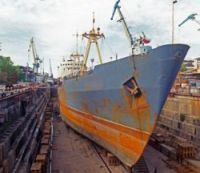

A & P Falmouth Ltd. has been fined £10,000 and ordered to pay £14,300 in costs for polluting Cornwall's Fal estuary with toxic paint sludge.
The Environment Agency were alerted to a report of pollution in September 2011, and upon arrival at the estuary they found a rusty-coloured plume in the harbour about the size of a football pitch. This was traced to Falmouth Docks where A & P Falmouth Ltd were refurbishing the Cardigan Bay, a Royal Fleet Auxiliary vessel. High pressure jets were being used to remove antifouling paint from the hull.
Whilst the majority of the blast spraying was done by a large machine that collected paint particles, a smaller machine and hand lances were used on the underside of the ship. As the smaller machine did not collect paint particles, paint flakes and sludge escaped into the dock, making their way eventually to the estuary, a Site of Special Scientific Interest (SSSI) and a Special Area of Conservation (SAC), after the dock was hosed out.
Further analysis found that the paint contained the highly toxic Tributyltin (TBT), a substance once used in antifouling paint which was banned in 2008. The company's permit does not allow them to treat with TBT, but a certificate supplied by the Ministry of Defence claimed that TBT-free paint was delivered to the vessel when it was last painted in 2009, although it couldn't guarantee that the same paint was applied.
A & P Falmouth Ltd pleaded guilty to two offences, including causing a polluting discharge to enter tidal waters and being in breach of its Local Authority permit.
Redwyn Sterry from the Environment Agency said, "These offences were avoidable. While we accept the company was not aware of the presence of TBT, it should have made greater efforts to monitor the content of the effluent that was being washed down the drain and installed an effective filter system to capture paint flakes and other potentially harmful residues produced as part of its ship refurbishment operations."
Since the incident, the company has started using hessian filters to capture potentially harmful substances and reduce the risk of pollutants escaping into the estuary.